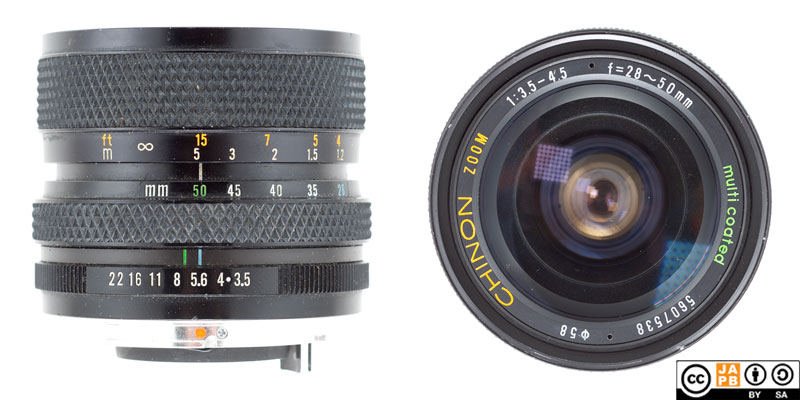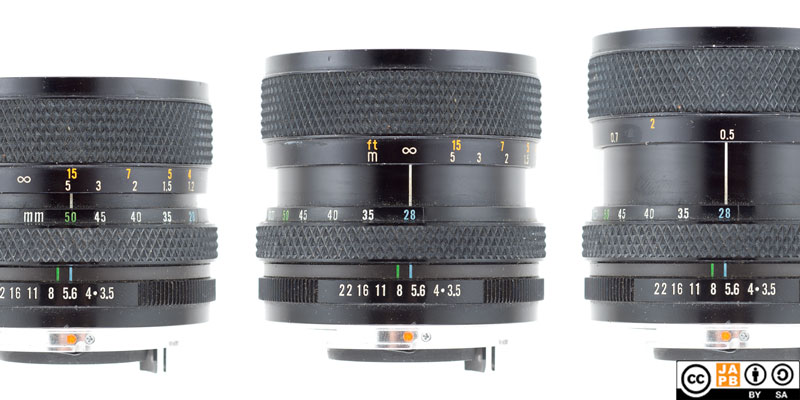Pekka Buttler, 02/2025

Specifications
The table below summarises the lens’ key specifications (measurements based on pictured sample):
| Brand: | Chinon | Lens name | Zoom 28–50mm 1:3.5–4.5 multicoated |
| Focal length range1 | 28–50 mm | Angle-of-view2 | 75.4° – 46.8° |
| Maximum Aperture | f/3.5–4.5 | In Production | 1980s3 |
| Lens mount | Pentax K | Subfamily (if applicable) | –– |
| Length4 | 51,8 mm | Diameter5 | 63,6 mm |
| Filter ring diameter | 58 mm | Weight | 268 grams |
| Lens element count | 9 | Lens group count | 9 |
| Aperture blades (S/R/C)6 | 5 S | Focus throw | 180 ° |
| Minimum focusing distance (measured) | 58 cm (@28 mm) 52 cm (@50 mm) | Maximum magnification (measured) | 1:19,1 (@28 mm) 1:10,2 (@50 mm) |
| Has manual aperture ring | YES | Has Manual focus ring | YES |
| Aperture mechanism type | Automatic | Aperture click stops7 | 3.5-4-5.6-8-11-16-22 |
Further notes:
• This is a rather compact wide-angle zoom lens.
• While the 28–50 mm zoom range is today rather odd, this zoom range was rather popular for a period in the late 1970s–early 80s, with many major manufacturers (Canon, Mamiya, Minolta8, Nikon, Olympus9, Pentax, Yashica) as well as a broad range of second tier manufacturers (including Cosina, Komine, Sigma, Soligor, Tamron) manufacturing these lenses.
• The Chinon 28-50 mm lens is a two-ring zoom with the front ring controlling focus and the rear ring controlling focal length (zoom).
• The lens changes shape when zooming. The lens is at its longest at the 28 mm setting, and shortest at the 50 mm setting. The overall zoom extension is ≈6 millimetres.
• Furthermore the lens changes length when focusing and the focus extension is another ≈4 millimetres.
• The filter threads rotate when focusing.
• This lens offers a semi-decent minimum focusing distance for a legacy zoom lens.

Middle: Chinon Zoom MC 28–50mm f/3.5-4.5 @ 28mm at infinity
Right: Chinon Zoom MC 28–50mm f/3.5-4.5 @ 28mm at MFD
Versions and origins
Somewhat surprisingly, there would seem to be multiple cosmetic versions of the Chinon 28-50mm f/3.5–4.5 lens. Besides my own lens (pictured above) most of these other variants I have only seen online, and I can only speculate on their origins, optical design or chronology. What I can however do is describe their name ring text, ergonomics as well as some other characteristics:
| Version | Name ring text | filter thread diameter | aperture blades | one-ring/two-ring | grip pattern | sample serial nos# | notes |
| A | Auto Chinon Zoom MC 28–50mm 1:3.5–4.5 | 58 mm | 5 | two-ring | rubber ribbing | 605639 | “Auto Chinon Zoom” in yellow, “MC” in green.10 |
| B | Chinon Zoom 1:3.5-4.5 f=28~50 multicoated | 58 mm | 5 | two-ring | rubber diamond pattern | 5601370, 5605708, 5606118, 5607538 | (this lens) “Chinon Zoom” in yellow and “multicoated” in green |
| C | Chinon 1:3.5–4.5 f=28-50mm multi coated | 55 mm | 6 | two-ring | rubber diamond pattern | 926296, 960894 | “multi coated” in green. 11 |
| D | Auto Chinon Zoom MC Macro 28~50mm 1:3.5~4.5 | 52 mm | 5 | two-ring | rubber pyramid pattern | 411566, 413116 | “Auto Chinon Zoom” in yellow, “MC” in green and “Macro” in blue. 12 |
Chinon did not manufacture its own lenses (Chinon focused on camera manufacture), instead sourcing its lenses from various Japanese lens manufacturers, ranging from small manufacturers few have ever heard about to well-known (and -respected) companies such as Tomioka.
Often it is possible to – through the sleuthwork of comparing a Chinon lens to other lenses – deduce something about the likely manufacturers. In this case however I have only guesses. Unless one of my well-informed readers can effectively enlighten me, we will have to accept that the origin story of this Chinon lens will not be uncovered here.
Chinon company profile
Chinon is known to still photographers as one of the more advanced 2nd tier Japanese cameramakers. From 1971 to the late 1980s Chinon was known to enthusiast photographers the world over for combining technological advancements in cost-effective cameras bodies. See more details in the Chinon company profile.
Adapting
n.B! The following applies to all non-electronic Pentax K mount lenses.
If you want to natively mount this lens you need to find a functioning Pentax K mount SLR (or a dSLR) camera. Luckily that should be relatively easy as Pentax K film bodies were produced in their millions and most of them – especially those manufactured by Pentax – have a good reliability record. Alternatively, you can use this lens natively on any Pentax dSLR.
Adapting this lens to a mirrorless, full-frame digital camera is a breeze thanks to the lens having full manual controls (aperture ring, focus ring). You simply need a dumb adapter from Pentax K to your mirrorless system.
Due to the medium flange focal distance used by the m42 mount (45,46 mm), whether you can adapt this lens to other than Pentax’ dSLR mounts depends on which dSLR mount: Canon EF, and Four Thirds can mount Pentax K lenses using a simple adapter ring. Minolta/Sony A and Nikon F on the other hand are not as problem-free, and – to retain anything near infinity focus – the adapter will necessitate corrective optics. In all cases, your camera will work only in stop-down metering.
Footnotes
- Focal length is (unless stated otherwise) given in absolute terms (not in Full-frame equivalent), and according to the manufacturer’s naming practice (which does not always reflect the lens’ actual field of view). For an understanding of whether the lens is wide/tele, see ‘Angle-of-view’. ↩︎
- Picture angle is given in degrees and concerns the diagonal picture angle. Rule of thumb:
> 90 ° ==> Ultra-wide-angle
70–90 ° ==> Wide-angle
50–70 ° ==> Moderate wide-angle
40–50 ° ==> ‘Standard’ or ‘normal’ lens
20–40 ° ==> Short tele lens
10-20 ° ==> Tele lens
5-10 ° ==> Long tele lens
< 5 ° ==> Ultra-tele lens ↩︎ - Documentation (e.g. brochures) of Chinon lenses are scarce and manuals are of no help in trying to date Chinon lenses as pictures in manuals surprisingly often show lenses that differ from those that were actually produced. Hence, dating these lenses is surprisingly difficult. ↩︎
- Length is given from the mount flange to the front of lens at infinity. Measured unless stated otherwise. ↩︎
- Diameter excludes protrusions such as rabbit ears or stop-down levers. Measured unless stated otherwise. ↩︎
- S=straight; R=rounded; C=(almost)circular at all apertures. ↩︎
- Numbers equal aperture values on aperture ring; • intermediate click; – no intermediate click. ↩︎
- Minolta’s offering was a 24–50 mm lens. ↩︎
- Olympus’ wide-to-standard zoom was a 28–48 mm lens. ↩︎
- https://www.ebay.de/itm/305955422025 ↩︎
- https://www.ebay.de/itm/335620506587 ↩︎
- https://www.ebay.de/itm/276717157795 ↩︎